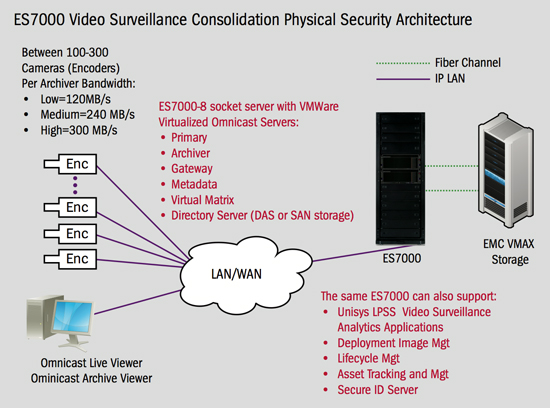How video surveillance solutions enable an IT department to assist security officers to economically and effectively respond to physical threats and cover the gamut of security challenges faced by today’s businesses
by Stephen Guarrieri & Marshall R. Bigelow, Unisys
 Today’s video surveillance solutions are becoming more critical to the enterprise, through real time deterrence and monitoring, as well as through analysis of recorded and/or documented security events. The typical approach to video surveillance relies on large server farms comprised of commodity two-socket servers – such server farms are both expensive to run and unwieldy to manage. Unisys, in concert with EMC, is introducing a new approach to video surveillance that addresses these cost and management challenges.
Today’s video surveillance solutions are becoming more critical to the enterprise, through real time deterrence and monitoring, as well as through analysis of recorded and/or documented security events. The typical approach to video surveillance relies on large server farms comprised of commodity two-socket servers – such server farms are both expensive to run and unwieldy to manage. Unisys, in concert with EMC, is introducing a new approach to video surveillance that addresses these cost and management challenges.
This consolidation solution is anchored by a highly scalable Unisys ES7000 server which allows for the elimination of commodity server farms. One ES7000 server can replace up to 42 commodity servers – reducing Total Cost of Ownership (TCO) by up to 50%.A series of performance tests have been run to demonstrate the technical viability of this solution.
Video surveillance is a key technology used by organizations around the world to defend and protect people, places, things and data. With the advancement of internet protocol (IP) – based video solutions, organizations are working to determine the optimal technical implementation strategy while lowering the TCO –balancing the cost of a video surveillance security service with effectively managing the wealth of information gathered.
One of the key challenges to improving the TCO of a video surveillance solution is the high cost driven by the broad use of proprietary hardware and software. These costs include upgrading DVR (digital video recording) and related proprietary hardware and software used by most DVR vendors. Additionally, most video surveillance systems do not have cost effective archive solutions and have implemented scale out technologies to address the increasing server and storage demands related to high bandwidth, video-capture and associated requirements driven by service level objectives and data analytics.
Parameters
Video quality and data viability has a relationship to camera and archiver server parameters. IP camera capture is based upon megabits per second (Mbps) while the archiver retention of video storage is rated at the parameter of megabytes per second (MB/s) frame storage capacity. Higher quality digital video and higher density of IP video cameras require more archiver servers to ensure network bandwidth requirements are met and application performance can scale with increased workloads. Thus driving the installation of ever-larger server farms.
Scaling-out digital video archiver servers and DVR servers can be a complex and costly proposition. Cost increases in a scale out solution are driven by extended network complexity, client and host server management, software licensing and maintenance as well as the capital and operating expenses associated with acquiring and supplying the floor-space, power and cooling that these servers require. Additionally, commodity servers in a scale-out solution service a limited number of IP cameras depending on bandwidth requirements. Reducing the TCO through server consolidation by extending and scaling-up the compute complex and the storage system is the more optimal solution.
Surveillance consolidation
The scale-up ES7000 enterprise servers and EMC system storage arrays converge to become the video surveillance consolidation solution with the scalability to enable a more network-centric, digital video surveillance architecture which effectively meets the needs of both IT and security departments. The solution provides robust RAM memory, CPU resources, VM scaling and integrated infrastructure management to meet the needs of an enterprise-class environment.
Server farms
Each architectural tier in the datacenter (web-, application-, database-) must be powerful enough to meet enterprise requirements for flexibility, reliability and ease of management, while causing no disruptions to continuous recording and video availability. The solution meets these requirements and is able to scale easily to accommodate higher resolution cameras, the use of video analytics and the long-term retention of digital video. It has been documented through a series of performance tests conducted by Unisys and EMC.
The tests started by examining the typical architecture in use today – huge ‘server farms’ based on commodity two socket servers. A typical server of this nature will manage approximately 20-30 cameras. On this basis, if a facility (airport, rail station, energy utility) needs 1000 cameras, the total server count will be approximately 40 with no redundancy. This was therefore the baseline used for comparison as it represents a typical approach in the market today.
The testing methodology moved on to determine how many cameras could be supported on one ES7000 server. The tests conducted in EMC’s labs showed that 42 commodity servers, could be replaced with just one ES7000 8 socket server, supporting greater than 1000 cameras (depending on camera and archiver configurations which affect the bandwidth requirements).
The savings delivered by achieving a 42:1 server consolidation ratio are dramatic. As well as an obvious saving in acquisition and operating costs there is a significant saving in the use of power, in the reduction in heat generated, thus less cost required for cooling the data center, and therefore higher return on investment. Virtualization on a scale-up server maximizes workload utilization of the physical servers for a dramatic reduction in TCO of platforms by supporting one or more solution requirements including more cameras, new higher resolution cameras, secure transmission, video analytics and etc.
Virtualization technology
Enterprise class solutions which include virtualization technology need to carefully consider server and storage characteristics. Migrating applications to a virtual environment while scaling the number of VMs requires large scale computing (number of processor cores), that are augmented by significant memory (a typical bottleneck in scaling VMs) and I/O capacity. Enterprise requirements include near-linear scalability, capacity headroom, and high availability. Organizations expect enterprise solutions to protect their mission critical and secure applications through embedded high availability and business continuity technology. They also want to increase maintainability through automated operations, configuration flexibility and overall end-to-end security continuity.
Sizing of the virtual machines must consider more than the specific application CPU, memory and I/O requirements. It must also consider the aggregate requirements from the shared resource pool including network and storage bandwidth.
For an enterprise class solution, the hypervisor must emphasize security, scalability and manageability as core architectural and design requirements. Some commodity hypervisors perform limited penetration testing for potential security ‘holes’ and use smaller test configurations, presenting potential issues for scalable enterprise environments.
An advanced video surveillance system could support tens of thousands of video cameras, and an unrestricted number of client workstations and other system components. An advanced video management system (VMS) must accommodate multiple formats of video data streaming.
IP cameras and video surveillance archivers are highly dependent upon the bandwidth of the LAN/WAN as well as the access speed for I/O to/from the storage platforms. The storage platform must be a high-performance platform that can be configurable to integrate seamlessly into an existing datacenter.
Finally, the network and storage should support multi-path I/O for resiliency operation and optimal performance through load balancing. Where data / applications are sensitive, data at rest encryption is often included in the data path using drive-level encryption.
Integration
The Unisys ES7000 Enterprise Server is a candidate to host virtualized applications. This platform has scalability from 2 to 4 to 8-sockets providing a growth path for future demand, massive amounts of CPU, memory, network and disk resource, the highest consolidation ratios (due to highest headroom levels), and a simple, single-pane-of-glass management scheme (versus multitude of management windows required with a scale out architecture).
Integration is demonstrated with 64 DIMM slots within the 4 socket system or 96 DIMM slots with memory expansion as well as seven PCIe Gen2 slots and up to eight internal HDDs. The platform is scalable to 8 sockets and 128 DIMMs or 192 DIMMs with Memory Expansion Modules. This feature increases the size and number of virtual machines (VMs) and the size and speed of databases that are supported. In a true enterprise platform, with the support of higher performance processors and balanced memory and I/O subsystems, the application realizes improved response times. Superior memory capacity per processor supports the needs of virtualization servers.
The memory subsystem and expansion capabilities increase VMs, database size and performance by expanding memory rather than by requiring the purchase of additional systems. It also allows the user to configure less expensive DIMMs to reach desired memory capacity. In some cases, the user can reduce software license costs by expanding memory capacity rather than purchasing more processors. The memory technology helps to lower cost, lower latency, increase bandwidth, and lower power consumption with advanced memory expansion and proprietary memory controllers.
The system has the ability to expand memory, CPU, and I/O independently. Therefore, solutions can be sized accordingly to invest in only the technology that is needed to meet performance and availability requirements. Flexible partitioning capability and automatic failover can maximize uptime. The platform also includes automatic ‘fail-down’ of the scalability links between the processors, single node failover, in-rack service position, first failure data capture, memory ECC, chipkill, double chipkill, memory mirroring, redundant & hot plug power and redundant & hot plug cooling (single node).
Automated system management makes the solution and environment easier to monitor, control and maintain. Similarly, the EMC enterprise-class storage arrays, including the VMAX, VNX and Isilon systems, enjoy an equally robust set of performance and availability attributes that contribute to the solution’s overall enterprise-class character.
Testing
The tests demonstrated the capabilities of the architecture and the scalability of VMware and Genetec Omnicast software. Utilization per video simulator was determined and extrapolated into per archiver utilization to determine the total number of archivers. Benchmark results found that during the 34 archiver testing as well as the 16 archiver testing, video simulators running on the same ES7000 consumed 45% and 54% respectivey which resulted in 95% CPU utilization.
Linearity testing shows the average per VM guest CPU utilization tends to increase as more VM guests are added. This indicated a slightly non-linear scalability profile. The test results also yielded interesting data-points, including the maximum number of archivers and simulators that an ES7000 server can accommodate running at low bandwidth 120Mbps/15MBps per archiver. In the low bandwidth camera test, the host CPU reached 91% utilization with 71 VM guests. At this stage consumed memory was 71% and active memory was 34%. All the archivers were writing ~15MBps to the VMAX array without errors.
Bandwidth
Additional tests determined the maximum number of archivers and simulators that a server can accommodate running moderate bandwidth at 240Mbps/30MBps per archiver as well as moderate bandwidth at 300Mbps/37MBps per archiver. For the primary set of tests, even under more intense CPU workload the host CPU utilization increased linearly as the number of VM guests increased. Lab results were based on isolated networks, dedicated hosts, dedicated arrays, consistent video, etc., implying that a production implementation will see variances.

